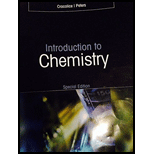
Concept explainers
Interpretation:
The name of element, nuclear symbol,
Concept introduction:
An atom is the smallest unit of matter. This smallest unit exhibits properties of chemical element. An atom consists of three sub-atomic particles such as electrons, protons and neutrons. Electrons are negatively charged, protons are positively charged and neutrons are neutral in nature.
Answer to Problem 25E
The table on completion is shown below.
| Name of Element |
Nuclear Symbol | Mass Number | Protons |
Neutrons |
Electrons |
|
| Scandium | ||||||
| Germanium | ||||||
| Tin | ||||||
| Chlorine | ||||||
| Sodium |
Explanation of Solution
Atomic number is the number of protons. In a neutral atom, the number of protons is equal to the number of electrons. Mass number of a neutral atom is equal to the sum of number of neutrons and number of protons.
An atom is represented as shown below.
Where,
•
•
•
Calculation of number of neutrons is shown below.
Where,
•
•
The table to be filled is given below.
| Name of Element |
Nuclear Symbol | Atomic Number | Mass Number | Protons |
Neutrons |
Electrons |
For first row, the number of electrons is equal to number of protons and atomic number that is
Substitute the value of
Therefore, mass number is
For second row, the nuclear symbol is
On comparison with the above stated atomic representation, atomic number of
Substitute the value of
Therefore, the number of neutrons is
For third row, The mass number is
Therefore, the atomic number is
For fourth row, the mass number is
The element is identified as Chlorine with nuclear symbol
For fifth row, the atomic number is
Therefore, the mass number is
The table on completion for the required values on the basis of atomic representation has been rightfully stated above.
Want to see more full solutions like this?
Chapter 5 Solutions
Introduction to Chemistry, Special Edition
- What is the final product when D-galactose reacts with hydroxylamine?arrow_forwardIndicate the formula of the product obtained by reacting methyl 5-chloro-5-oxopentanoate with 1 mole of 4-penten-1-ylmagnesium bromide.arrow_forwardIn the two chair conformations of glucose, the most stable is the one with all the OH groups in the equatorial position. Is this correct?arrow_forward
- please help me with my homeworkarrow_forwardhelparrow_forwardThe temperature on a sample of pure X held at 1.25 atm and -54. °C is increased until the sample boils. The temperature is then held constant and the pressure is decreased by 0.42 atm. On the phase diagram below draw a path that shows this set of changes. pressure (atm) 2 0 0 200 400 temperature (K) Xarrow_forward
- QUESTION: Answer Question 5: 'Calculating standard error of regression' STEP 1 by filling in all the empty green boxes *The values are all provided in the photo attached*arrow_forwardpressure (atm) 3 The pressure on a sample of pure X held at 47. °C and 0.88 atm is increased until the sample condenses. The pressure is then held constant and the temperature is decreased by 82. °C. On the phase diagram below draw a path that shows this set of changes. 0 0 200 temperature (K) 400 аarrow_forwarder your payment details | bar xb Home | bartleby x + aleksogi/x/isl.exe/1o u-lgNskr7j8P3jH-1Qs_pBanHhviTCeeBZbufuBYT0Hz7m7D3ZcW81NC1d8Kzb4srFik1OUFhKMUXzhGpw7k1 O States of Matter Sketching a described thermodynamic change on a phase diagram 0/5 The pressure on a sample of pure X held at 47. °C and 0.88 atm is increased until the sample condenses. The pressure is then held constant and the temperature is decreased by 82. °C. On the phase diagram below draw a path that shows this set of changes. pressure (atm) 1 3- 0- 0 200 Explanation Check temperature (K) 400 X Q Search L G 2025 McGraw Hill LLC. All Rights Reserved Terms of Use Privacy Cearrow_forward
 Introductory Chemistry: An Active Learning Approa...ChemistryISBN:9781305079250Author:Mark S. Cracolice, Ed PetersPublisher:Cengage LearningChemistry: Matter and ChangeChemistryISBN:9780078746376Author:Dinah Zike, Laurel Dingrando, Nicholas Hainen, Cheryl WistromPublisher:Glencoe/McGraw-Hill School Pub Co
Introductory Chemistry: An Active Learning Approa...ChemistryISBN:9781305079250Author:Mark S. Cracolice, Ed PetersPublisher:Cengage LearningChemistry: Matter and ChangeChemistryISBN:9780078746376Author:Dinah Zike, Laurel Dingrando, Nicholas Hainen, Cheryl WistromPublisher:Glencoe/McGraw-Hill School Pub Co Chemistry & Chemical ReactivityChemistryISBN:9781337399074Author:John C. Kotz, Paul M. Treichel, John Townsend, David TreichelPublisher:Cengage Learning
Chemistry & Chemical ReactivityChemistryISBN:9781337399074Author:John C. Kotz, Paul M. Treichel, John Townsend, David TreichelPublisher:Cengage Learning Chemistry & Chemical ReactivityChemistryISBN:9781133949640Author:John C. Kotz, Paul M. Treichel, John Townsend, David TreichelPublisher:Cengage Learning
Chemistry & Chemical ReactivityChemistryISBN:9781133949640Author:John C. Kotz, Paul M. Treichel, John Townsend, David TreichelPublisher:Cengage Learning Chemistry for Today: General, Organic, and Bioche...ChemistryISBN:9781305960060Author:Spencer L. Seager, Michael R. Slabaugh, Maren S. HansenPublisher:Cengage Learning
Chemistry for Today: General, Organic, and Bioche...ChemistryISBN:9781305960060Author:Spencer L. Seager, Michael R. Slabaugh, Maren S. HansenPublisher:Cengage Learning





